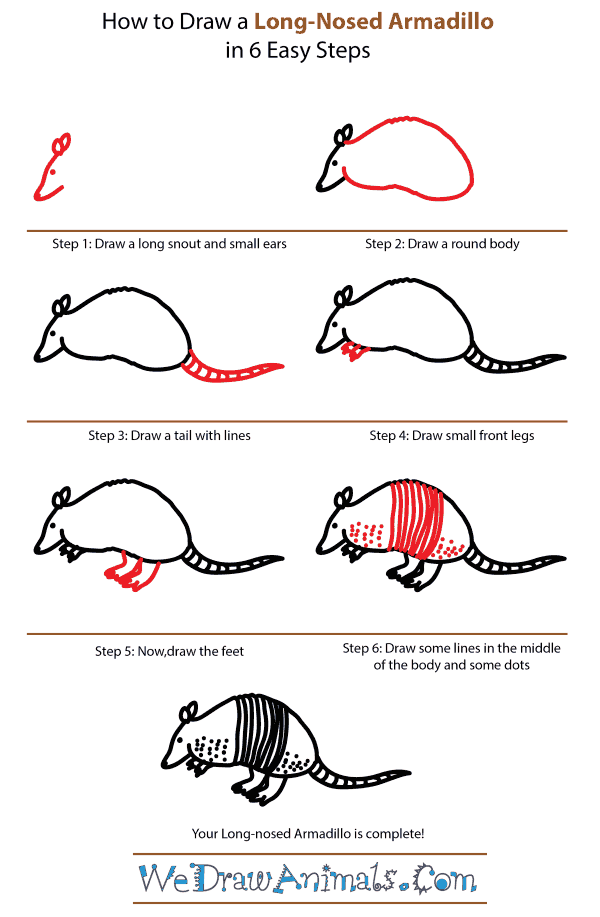In this quick tutorial you'll learn how to draw a Long Nosed Armadillo in 6 easy steps - great for kids and novice artists.
The images above represent how your finished drawing is going to look and the steps involved.
Below are the individual steps - you can click on each one for a High Resolution printable PDF version.
At the bottom you can read some interesting facts about the Long Nosed Armadillo.
Make sure you also check out any of the hundreds of drawing tutorials grouped by category.
How to Draw a Long Nosed Armadillo - Step-by-Step Tutorial
Step 1: Draw a long snout with small, oval shaped ears
Step 2: Draw a potato shaped body
Step 3: Add a long tail with lines in it. It will look like a rat's tail)
Step 4: Draw very small front legs beneath the chin
Step 5: Draw the hind legs just before the tail, they will be bigger than the front
Step 6: Add lines down the middle of its body (up and down) and dots on either side of the lines towards the bottom of the body
Interesting Facts about the Long-Nosed Armadillo
The long-nosed armadillo, also known as the nine-banded armadillo, occurs in the southern United States through Mexico and Central America, as well as Argentina in South America. They exist at altitudes up to two thousand meters above sea level, as well as the regions of Trinidad, Grenada and Tobago. They are a common species with no threat to their population numbers, and their species consists of six subspecies. In addition to being rather stable in population, the long-nosed armadillo is also very adaptable, as they can live in a high variety of habitats. Because this armadillo has a high reproduction rate, often birthing quadruplets, their numbers are always bolstered enough to remain common and not at all risking endangerment. They are often hunted as well, which should cause a steady decrease in their numbers, but it does not. They are also hunted because they are perceived as a nuisance by area farmers.
Did you know?
- The long-nosed armadillo originated in South America, which is where the entirety of the population remained until the formation of the Isthmus of Panama that connects South America to Central America.
- They can live nearly anywhere, but vastly prefer rainforests, grasslands and dry shrubs, where their preferred fare of small invertebrate prey are common.
- This species of armadillo can jump up to four feet in the air when it is sufficiently startled.
- Clever predators as they are, the long-nosed armadillo will roll its armored body over anthills to destroy them and then lick up the ants that come out with their sticky tongues.
- This armadillo is both solitary in nature and mainly nocturnal.
- They are often hunted for commercial purposes. There are three main reasons why they are hunted: for a source of protein, for handicrafts, and less commonly for medicinal means.
This armadillo can grow up to fourteen and a half pounds and forty-two inches in length from the end of its long snout to the tip of its armored tail. Almost the entire body of this animal is covered in an armor-like hide, as well as tough skin and coarse hair. Their entire bodies are built for digging, from its snout that can smell up to eight inches into the soil, to the long middle nails on their toes that help them carve their way into the earth. Because they have a low metabolic rate and little fat, the long-nosed armadillo is prone to becoming sick from the cold rather easily.







